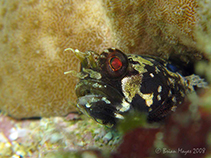| Family: |
Gobiidae (Gobies), subfamily: Gobiinae |
| Max. size: |
2.23 cm SL (male/unsexed); 2.49 cm SL (female) |
| Environment: |
demersal; marine; depth range 8 - 11 m |
| Distribution: |
Western Indian Ocean: Socotra Island, |
| Diagnosis: |
Dorsal spines (total): 7-7; Dorsal soft rays (total): 12-12; Anal spines: 1-1; Anal soft rays: 11-11. This species is distinguished by the following characters: D VI+I,12; A I,11; pectoral-fin rays 15-16 with all rays branched; pelvic-fin rays I,5, the fins separated and without frenum, with fifth ray unbranched; anterior nostril a moderately long tube with the process extending from median side of rim (as tentacle longer than tube) or as a slender flap which is slightly shorter than tube; posterior nostril a long tube with two tentacles, the anterior one is long, the posterior shorter; no tentacle is above the eye; mouth is moderately large, posterior angle of jaws behind vertical through posterior edge of eye; opercular spine absent; with a small mental frenum; pelvic fins end distantly well in front of anus; head and body are mainly naked except for several ctenoid scales on caudal peduncle at caudal-fin base; head with anterior oculoscapular canal and preopercular canal, no posterior oculoscapular canal; anterior oculoscapular canal pores with erected rim; suborbital rows of papillae are in five transverse rows. Colouration: above the opercle is a nearly rounded dark blue or blackish spot as large as pupil; a large irregular white blotch on the postorbital head, cheek and lower preopercle (Ref. 125392). |
| Biology: |
Collected on rubble-sand patches in sandy areas and in areas with mixed corals and stones or rocks. The holotype and paratypes were found living inside small holes in moderately large pieces of coral rock covered with short algae (Ref. 125392). |
| IUCN Red List Status: |
Not Evaluated (N.E.) Ref. (130435)
|
| Threat to humans: |
harmless |
Source and more info: www.fishbase.org. For personal, classroom, and other internal use only. Not for publication.
